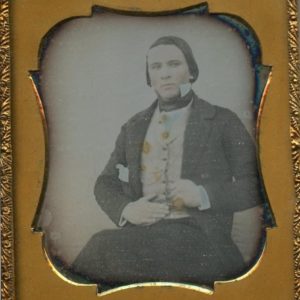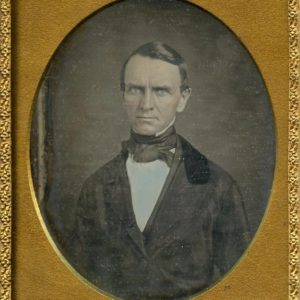Description
Andersonville (or Camp Sumpter as it was known) Prison was built in early 1864 in order to move the large number of Federal prisoners in and around Richmond to a place of greater security and more abundant food. The prison was surrounded by a stockade of logs with sentry boxes at 90-foot intervals. There were two entrances on the west side. Inside the pen and about 19 feet from the stockade was the deadline which prisoners were forbidden to cross. Over 45,000 Federal prisoners were housed at Andersonville, with about 13,000 dying. At its most crowded, Andersonville held more than 32,000 men in a compound of about 26.5 acres. It ceased operation in May 1865. When the war ended, Captain Henry Wirz, the stockade commander, was arrested and charged with “murder, in violation of the laws of war.” Tried and found guilty by a military tribunal, Wirz was hanged in Washington, D,C. on November 10, 1865.
On August 17, 1864 Macon, Georgia photographer Andrew Jackson Riddle took seven views of Andersonville. The views were Southwest, Southeast, Northeast, North Angle, Bird’s Eye View, Burying Party in Grave Yard, and Northwest View, and are the only known views of Andersonville. The original views were secured in 1865 by Theodore Wiseman, in an old chest from Captain Wirz’s house at Andersonville. He sold sets of the seven views, copywriting them in 1883. The images were set on card stock, with printed description of the view on the recto and printed description of the set and Andersonville story on the verso. Versions are also extant that have hand-written descriptions. I do not know for sure, but believe that these were issued earlier than the ones with printed descriptions on the card stock. They were likely also issued by Wiseman, unless Riddle sold some after taking the photographs. In either case, they are rare and desirable photographs of the most infamous Confederate prison.
The image for sale here is the Southeast view. Written in period ink on the verso is “Southwest view taken from the branch. Sentinel tree on the left. &c. &c.” The image is incorrectly marked and is actually the Southeast view. The name “W. F. Porter” is written in period ink on the lower left side of the verso. I do not know who that person was. As noted by former prisoner Sergeant Warren L. Goss of Co. H, 2nd Massachusetts Heavy Artillery, the picture shows prisoners using latrines in the foreground, a group involved in a court martial or trial of a prisoner on the left, a structure with four poles and a blanket roof used as a barber shop in the middle, masses of huts, and a stockade in front of woods in the distance. A very rare and historic photograph, indeed. Image size approximately 5 1/4 in. x 3 1/2 in.







